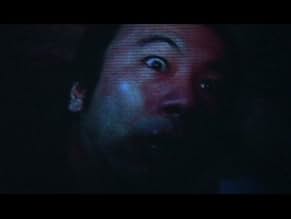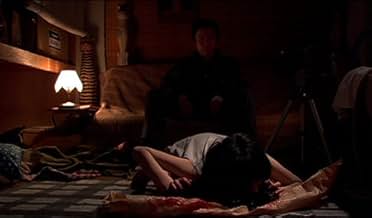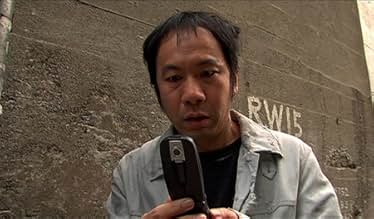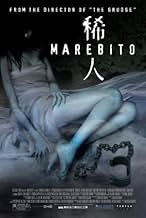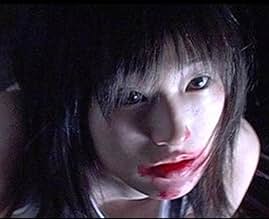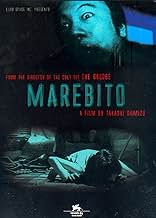AVALIAÇÃO DA IMDb
6,0/10
6 mil
SUA AVALIAÇÃO
Adicionar um enredo no seu idiomaA fear-obsessed freelance cameraman (Shinya Tsukamoto) investigates an urban legend involving mysterious spirits that haunt the subways of Tokyo.A fear-obsessed freelance cameraman (Shinya Tsukamoto) investigates an urban legend involving mysterious spirits that haunt the subways of Tokyo.A fear-obsessed freelance cameraman (Shinya Tsukamoto) investigates an urban legend involving mysterious spirits that haunt the subways of Tokyo.
- Direção
- Roteirista
- Artistas
- Prêmios
- 2 vitórias e 1 indicação no total
Avaliações em destaque
A strange film by Grudge writer/director Takashi Shimizu.
Shinya Tsukamoto (Ichi the Killer) is consumed with finding out the source of terror that caused a man to stab himself in the eye. He wants to experience the same terror - terror so horrible that it would cause you to want to kill yourself.
He goes underground looking for the beings that inhabit the tunnels under Tokyo and finds a naked girl, who he brings home to live with him. The girls is more animal than human and he kills to provide her blood rather than give her his own blood, which she wants.
It is not certain throughout whether he is going mad or finding what he is searching for. He even tries to escape, but resumes the search until he finally succumbs to the terror.
Despite the shaky camera work, which some like, but which distracts me, it was a fascinating look at terror and certainly a film that contains much more than available at first glance. A blend of mysticism and horror, it is a worthy view for fans of Japanese horror.
Shinya Tsukamoto (Ichi the Killer) is consumed with finding out the source of terror that caused a man to stab himself in the eye. He wants to experience the same terror - terror so horrible that it would cause you to want to kill yourself.
He goes underground looking for the beings that inhabit the tunnels under Tokyo and finds a naked girl, who he brings home to live with him. The girls is more animal than human and he kills to provide her blood rather than give her his own blood, which she wants.
It is not certain throughout whether he is going mad or finding what he is searching for. He even tries to escape, but resumes the search until he finally succumbs to the terror.
Despite the shaky camera work, which some like, but which distracts me, it was a fascinating look at terror and certainly a film that contains much more than available at first glance. A blend of mysticism and horror, it is a worthy view for fans of Japanese horror.
This sounded very interesting to me in an abstract/visual experiment kind of way when I read about it. Man takes a movie camera to the subway of Tokyo in search of unspeakable horrors and comes up with some to take back to his apartment. I love movies that take a peripatetic approach, that take us on walkabouts through weird/elaborate architecture, from The Shining to Last Year at Marienbad, and I hoped this would be one of the greats.
I like these films to be shot in DV, lights are harsh and cold and space attains an immediacy that appeals to me. If I was disappointed in this then it's not because it meanders and is short on plot but rather because the lovely visual experiment is used by Shimizu to tell a story of almost EC Comics simplicity, madness and damnation. The protagonist sees news footage of a man stabbing his eye in the Tokyo subway. The epiphany to go looking in the subway for that ultimate terror gleaming in the victim's eyes moments before his death comes seemingly after a quick mashup of superimposed images of video screens, white noise, and reaction shots of the character looking dazed - a visual slapdash chaos that seems like the director's way of saying "something clicked in his mind" and nothing more.
I like that Shimizu simply took a camera to the streets of Tokyo to make Marebito, we really don't see enough films of that kind by people who know how to make them, and I wish he would've used Hollow Earth as a springboard of ideas instead of making direct allusions to it. I was fascinated by the subject in my teens, as with other mystical theories I'm still shocked that there are people who take it at face value, as something more than interesting myth (Shimizu fortunately is not one of them), yet the discussion in the subway tunnel where a bunch of arcane references to the subject are bandied up serves nothing. I'm still glad that I saw it though, made me want to see some more Shinya Tsukamoto.
In the end, Marebito is about a man's struggle with his own madness, but it's a bit slapdash about telling us about it.
I like these films to be shot in DV, lights are harsh and cold and space attains an immediacy that appeals to me. If I was disappointed in this then it's not because it meanders and is short on plot but rather because the lovely visual experiment is used by Shimizu to tell a story of almost EC Comics simplicity, madness and damnation. The protagonist sees news footage of a man stabbing his eye in the Tokyo subway. The epiphany to go looking in the subway for that ultimate terror gleaming in the victim's eyes moments before his death comes seemingly after a quick mashup of superimposed images of video screens, white noise, and reaction shots of the character looking dazed - a visual slapdash chaos that seems like the director's way of saying "something clicked in his mind" and nothing more.
I like that Shimizu simply took a camera to the streets of Tokyo to make Marebito, we really don't see enough films of that kind by people who know how to make them, and I wish he would've used Hollow Earth as a springboard of ideas instead of making direct allusions to it. I was fascinated by the subject in my teens, as with other mystical theories I'm still shocked that there are people who take it at face value, as something more than interesting myth (Shimizu fortunately is not one of them), yet the discussion in the subway tunnel where a bunch of arcane references to the subject are bandied up serves nothing. I'm still glad that I saw it though, made me want to see some more Shinya Tsukamoto.
In the end, Marebito is about a man's struggle with his own madness, but it's a bit slapdash about telling us about it.
Marebito starts out with an interesting premise, but somewhere along the way the movie falls apart.
A camera man captures a man in the subway committing suicide by stabbing himself in the eye. The camera man becomes transfixed by the death image of the man and studies the footage with the hopes of finding a clue as to why the man would commit such an act. He surmises that the man has experienced something so terrifying immediately before his death as to render him suicidal. So the camera man ventures into the subway for clues and finds a door that leads even further down into the subway. The beginning part of the film captured my interest.
Too bad.
What the main lead uncovers...actually what he finds beneath the subway...and what unfolds thereafter is incredibly dull. The rest of the film becomes a jumbled mess as the main character tries to rationalize, in his more and more irrational mind, the supernatural events that unfold. But the film looks rushed and uninspired...it does look like it was filmed in two weeks.
I thought Ju-on was creepy and fairly good as a horror film. The director's effort on this film is unfocused and meandering; he even interlaces at points in the film, clumsily I might add, with discussions of philosophy and the supernatural in the hopes, I suppose, of lending the film some gravitas. Is the director trying to be metaphorical and deliberately obtuse? I don't know and I did not care.
Because I found some parts of the film creepy and even innovative, I rate this film: Average.
A camera man captures a man in the subway committing suicide by stabbing himself in the eye. The camera man becomes transfixed by the death image of the man and studies the footage with the hopes of finding a clue as to why the man would commit such an act. He surmises that the man has experienced something so terrifying immediately before his death as to render him suicidal. So the camera man ventures into the subway for clues and finds a door that leads even further down into the subway. The beginning part of the film captured my interest.
Too bad.
What the main lead uncovers...actually what he finds beneath the subway...and what unfolds thereafter is incredibly dull. The rest of the film becomes a jumbled mess as the main character tries to rationalize, in his more and more irrational mind, the supernatural events that unfold. But the film looks rushed and uninspired...it does look like it was filmed in two weeks.
I thought Ju-on was creepy and fairly good as a horror film. The director's effort on this film is unfocused and meandering; he even interlaces at points in the film, clumsily I might add, with discussions of philosophy and the supernatural in the hopes, I suppose, of lending the film some gravitas. Is the director trying to be metaphorical and deliberately obtuse? I don't know and I did not care.
Because I found some parts of the film creepy and even innovative, I rate this film: Average.
I highly suggest seeing this film if you are a fan of Shimizu's works. Apparently it was filmed before Ju-On, in only eight days. This shows what a master filmmaker can do in such a short time. This movie will make you feel very uncomfortable and extremely disturbed. It is about a camera man who wants nothing more than to feel the most extreme fear. He than finds a subterranean lair filled with eerie creatures called Deros, and he finds a girl (or a creature much like a girl) chained to a rock and takes her home to care for her. He attempts to feed her but he finds that the only thing that she'll eat is blood. The only problems I had with it were the shaky camera moves (Blair-Witch style)but since he only made it in eight days...he has an excuse, and it will go to a normal camera to give your eyes a break. Overall a masterpiece in psycho-horror.
In Tokyo, the freelancer cameraman Takuyoshi Masuoka (Shinya Tsukamoto) is obsessed investigating the fear sensation near death. When he shots with his camera a man stabbing himself in the eye in the access to the subway, he seeks what the suicidal might have seen to experiment the same sense of horror the man felt when he died. He finds a passage to the underground of Tokyo where he meets a mysterious naked woman that does not speak and he calls her F (Tomomi Miyashita). He brings F to his place and he has difficulties to feed her, until he discovers that she drinks blood. Masuika becomes a serial killer draining the blood of his victims to nurse F.
"Marebito" is a very weird low-budget movie that discloses the madness process of the lead character through his journey to hell in the underground of Tokyo. This original story is disturbing and unpleasant, using a morbid and creepy atmosphere, to unravel the twisted mind of a deranged man. However this strange movie is recommended for very specific audiences only. My vote is six.
Title (Brazil): "Marebito: Seres Estranhos" ("Marebito: Weird Beings")
"Marebito" is a very weird low-budget movie that discloses the madness process of the lead character through his journey to hell in the underground of Tokyo. This original story is disturbing and unpleasant, using a morbid and creepy atmosphere, to unravel the twisted mind of a deranged man. However this strange movie is recommended for very specific audiences only. My vote is six.
Title (Brazil): "Marebito: Seres Estranhos" ("Marebito: Weird Beings")
Você sabia?
- CuriosidadesTakashi Shimizu shot the film in just eight days, between the production dates for Ju-on: O Grito (2002) and its remake, O Grito (2004).
Principais escolhas
Faça login para avaliar e ver a lista de recomendações personalizadas
- How long is Marebito?Fornecido pela Alexa
Detalhes
Bilheteria
- Orçamento
- JP¥ 5.000.000 (estimativa)
- Faturamento bruto nos EUA e Canadá
- US$ 13.983
- Fim de semana de estreia nos EUA e Canadá
- US$ 3.852
- 11 de dez. de 2005
- Faturamento bruto mundial
- US$ 107.259
- Tempo de duração
- 1 h 32 min(92 min)
- Cor
- Proporção
- 1.85 : 1
Contribua para esta página
Sugerir uma alteração ou adicionar conteúdo ausente


